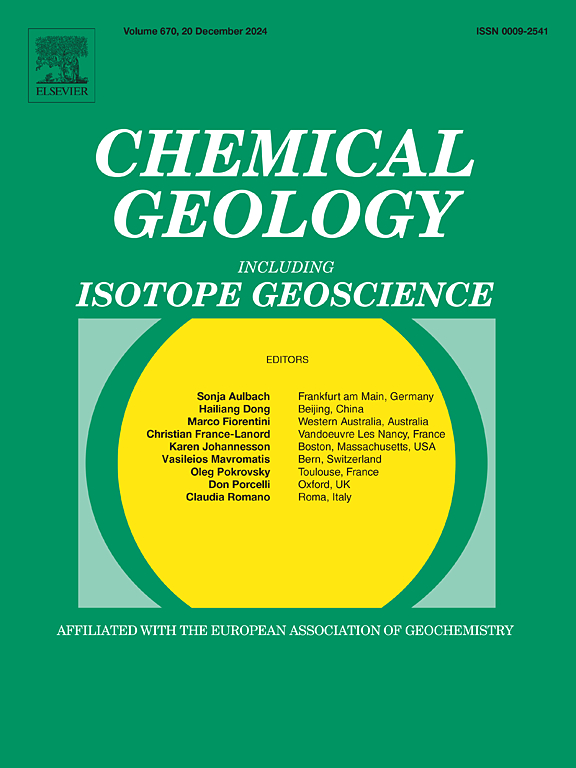Investigating pressure effects of Ti and Zr partitioning into zircon, quartz, and rutile at crustal temperatures
IF 3.6
2区 地球科学
Q1 GEOCHEMISTRY & GEOPHYSICS
引用次数: 0
Abstract
The dependency of Ti partitioning between quartz and zircon on the activity of TiO2 and Zr partitioning between zircon and rutile on the activity of ZrO2 suggest that an intercalibration among the three minerals (i.e., concentration information from all three phases in the same experiment) could reduce propagated errors when using multiple systems simultaneously. Experiments were undertaken to assess pressure effects in Ti and Zr partitioning in the zircon-quartz-rutile system and intercalibration of the three phases at low concentrations (down to ∼20 ppm). Analysis of small crystals (down to ∼8 μm) was possible due to the high spatial resolution of the CAMECA ims1290 ion microprobe. Regressions for pressure-temperature-phase domains for experiments between 800 and 1000 °C and 10 and 15 kbar array about the initial calibration data providing confidence in their merit despite recent criticisms. Ti and Zr partitioning into quartz, rutile, and zircon can be quantified as:
and
where T is temperature (Kelvin), P is pressure (kbar), concentrations have units of ppm, and is the activity of SiO2 referenced to α-quartz. Importantly, if α-quartz is present, is 1 and is zero.
在地壳温度下研究钛和锆在锆石、石英和金红石中的分馏压力效应
石英和锆石之间的Ti分配依赖于TiO2的活性,锆石和金红石之间的Zr分配依赖于ZrO2的活性,这表明三种矿物之间的相互校准(即在同一实验中来自所有三个相的浓度信息)可以减少同时使用多个系统时的传播误差。实验评估了压力对锆-石英-金红石体系中Ti和Zr分配的影响,并在低浓度(低至~ 20 ppm)下对三相进行了相互校准。由于CAMECA ims1290离子微探针的高空间分辨率,可以分析小晶体(小至~ 8 μm)。800至1000°C和10至15 kbar阵列之间实验的压力-温度相位域的回归关于初始校准数据,尽管最近受到批评,但仍对其优点提供了信心。Ti和Zr在石英、金红石和锆石中的分异可量化为:logTi−in−石英+ logasio_2 α−石英=6.71±0.11−383±10TK−0.122±0.07P−0.00197±0.00024P2logZr−in−金红石+ logasio_2 α−石英=7.39±0.21−4262±220TK−0.021±0.0051P
本文章由计算机程序翻译,如有差异,请以英文原文为准。
求助全文
约1分钟内获得全文
求助全文
来源期刊

Chemical Geology
地学-地球化学与地球物理
CiteScore
7.20
自引率
10.30%
发文量
374
审稿时长
3.6 months
期刊介绍:
Chemical Geology is an international journal that publishes original research papers on isotopic and elemental geochemistry, geochronology and cosmochemistry.
The Journal focuses on chemical processes in igneous, metamorphic, and sedimentary petrology, low- and high-temperature aqueous solutions, biogeochemistry, the environment and cosmochemistry.
Papers that are field, experimentally, or computationally based are appropriate if they are of broad international interest. The Journal generally does not publish papers that are primarily of regional or local interest, or which are primarily focused on remediation and applied geochemistry.
The Journal also welcomes innovative papers dealing with significant analytical advances that are of wide interest in the community and extend significantly beyond the scope of what would be included in the methods section of a standard research paper.
 求助内容:
求助内容: 应助结果提醒方式:
应助结果提醒方式:


